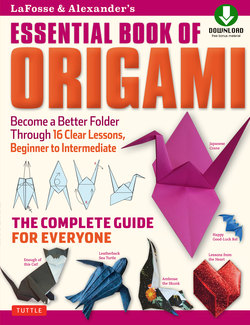Читать книгу LaFosse & Alexander's Essential Book of Origami - Michael G. LaFosse - Страница 7
На сайте Литреса книга снята с продажи.
ОглавлениеOrigami as Expressive Art
FOREWORD BY ORIGAMIDO STUDIO COFOUNDER RICHARD L. ALEXANDER
Origami as an expressive art form is relatively new, and in the last few decades has been marked by astounding innovation. This excitement is why Michael LaFosse and I founded Origamido Studio in 1996. There, we have been able to share our joy of designing and folding origami art through publishing, teaching and hosting hand-paper making workshops with other folding colleagues and artists. Michael named our studio “Origamido,” which is Japanese for “fold – paper – school.” The “do” suffix implies a long-term, dedicated study. Michael was familiar with this because his father learned Judo in the US Air Force (and later became an instructor himself), and Michael has also studied Taekwondo for over forty years. Many of our paper-folding students and customers share the “do” — that lifelong passion for origami. To us, it is much more than a hobby, and we have dozens of friends who use their annual vacation time to attend folding conventions now held all around the world.
What is origami art, and why might you want to study it? Although the invention of paper was documented in China about two thousand years ago, paper folding as a pastime seems to be only a few hundred years old. Until the last century, only a handful of objects were realized. It was (and still is) often dismissed as a trivial amusement for children. At best it was considered a folk craft.
Only since about the middle of the twentieth century has origami exploded in popularity, and there is now a class of paper folding that clearly rises above the craft level. We define origami art as folded paper that expresses the human spirit. So many artists now express emotions so elegantly through folded paper that major museums are booking origami masterworks presented as creative and expressive art, and attendance is raising eyebrows in the art world. Why is this so?
Michael once opened a public presentation with this thought: “Art reveals the unique and complex nature of expressive human beings. Origami is one of those art forms that appeals to both the logical and the emotional needs of the mind.” This richness of exploring the potential of the folded square spans the gamut, from single-fold sculptures to multi-piece geometric constructions illustrating concepts of higher mathematics. The Internet now makes it possible for such a previously obscure art form to become recognized and appreciated by a huge audience. Paper folding can and does efficiently provide a fertile field for a lifetime of enjoyable exploration and study for millions of people.
It is worth noting that most of our regular students are often proficient in other disciplines of the arts and sciences as well. Their backgrounds may include writing, engineering, mathematics, painting, photography, dance or music… and the mastery of any such endeavor benefits from a systematic approach to study and practice. Mathematicians love to solve puzzles to keep their reasoning skills sharp. Musicians practice scales and arpeggios to achieve and maintain technical competence. So too should origami students practice certain models to perfect and maintain essential folding skills. The benefit of doing so is proficiency, the gatekeeper of artistry. The value of many arts is often in the process itself, and that is certainly true with paper folding, where expression is not only in the final, folded form, but also in the beauty of the performance or the magic of the transformation during the folding sequence.
Origami artists come to work with us at Origamido Studio to improve their artistry. Lessons don’t only involve acquiring technical folding skills; sometimes they include help with choosing appropriate papers. In the world of origami art, the “look” of a piece of folded art is much more than just its physical appearance. Much of that look depends upon the intrinsic qualities of the chosen paper. Qualities such as strength or thinness may be critical to accommodating multiple layers, or subtle shaping to convey attitude or gestures.
Many artists simply love to learn more about the medium of paper and its fibers, in order to master the technical skills necessary to fold more artfully. We use a palette of strong plant fibers of many different types and qualities (soft and supple, to hard and rigid). Compromises can be maddening for artists, and so the ability to come to Origamido Studio to customize the perfect batch of handmade paper for each specific work of folded art is a dream come true. Artists can choose, prepare, blend and pigment the highest quality of fibers to form sheets of the perfect size and thickness (or thinness).
If you are new to origami, we suggest that you start with our Origami Studio DVD kit for beginners (Tuttle Publishing). It features thirty projects to illustrate basic origami folds and techniques. If you have already enjoyed those, or other origami lessons for beginners, and you are interested in exploring the artistry of folding, then this selection of origami projects was designed for you! Each one is an étude, or brief study, designed or selected for the advancing student to complete in one sitting. It was important for us to select models that not only teach key folding skills, but are also fun for you to fold repeatedly until you have mastered those skills.
